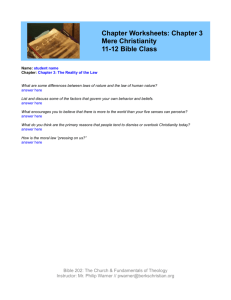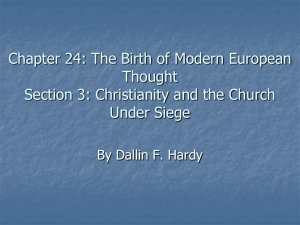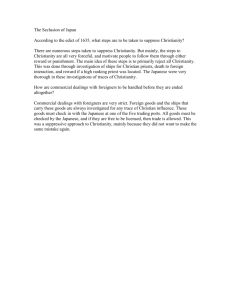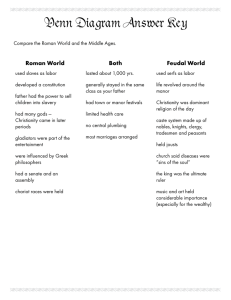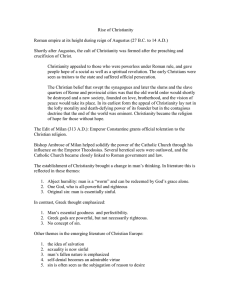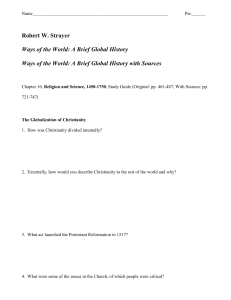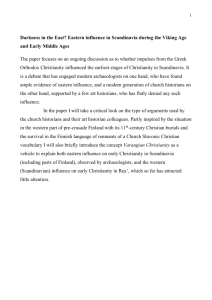Christianity
advertisement
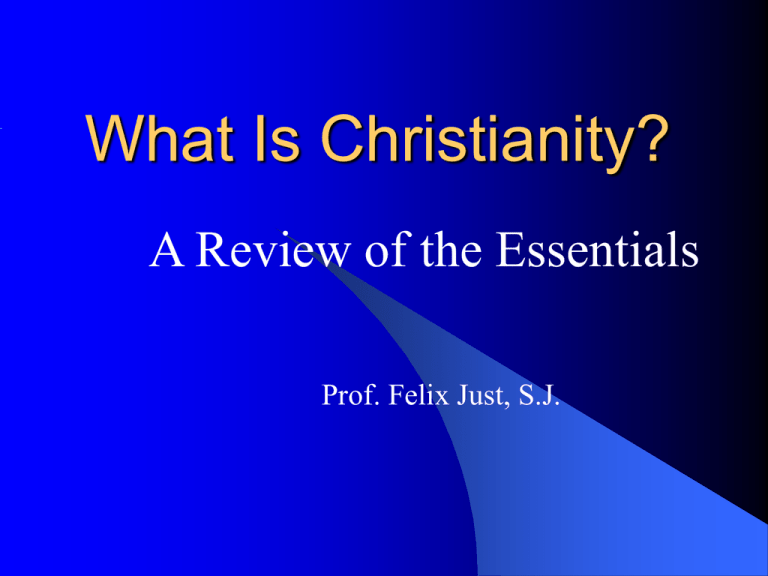
What Is Christianity? A Review of the Essentials Prof. Felix Just, S.J. Introduction: Christianity is a major world religion, – A“Western” religion (w/ Judaism & Islam) – The largest world religion today (ca. 2 billion) It is based on belief that Jesus of Nazareth is the “Christ” ( “Messiah”) & the “Son of God.” Like most other major world religions, Christianity has several core aspects: – I) History & Development – II) Core Beliefs & Practices – III) Structures & Regulations What Is Christianity? I-A: History 1) Historical Background: Abraham, Israelites, Hebrews, Jews, OT 2) Historical Foundation: Jesus of Nazareth (crucified ca. AD 30) & his first disciples/apostles 3) Historical Development: Tradition preserved/adapted 2000 years (interplay of both old & new, ancient & modern) What Is Christianity? I-B: Branches & Subdivisions 1) Major Christian Branches: (Eastern) Orthodox, (Roman) Catholic, Anglican, Protestant, Restorationist, etc. 2) Orthodox, Anglicans, Protestants: O: by nation & language: Greek, Russian… A: by nations: esp. former British colonies P: by leaders/theologies: Lutheran, Reformed… 3) Groups within Catholicism: religious orders & societies (monastic, mendicant, apostolic, etc.), lay groups What Is Christianity? I-C: Demographics 1) Number of Christians World-wide: ~ 2 billion in 2000; ~ 33% of world population 2) Subdivisions: 1 bill. Catholics; 500 mill. Protestant/Anglican; 250 mill. Orthodox; 250 mill. Other 3) % of Populations: 48% Africa; 85% N. America; 93% S. America; 9% Asia; 76% Europe; 85% Oceania What Is Christianity? II-A: Foundational Texts 1) The Bible: official collection of books, in two parts: both Old Testament & New Testament 2) The Creeds: short professions of faith, defined by first two Ecumenical Councils: Nicea & Constantinople 3) Other Writings: writings of Church leaders throughout history, esp. founders of orders & denominations What Is Christianity? II-B: Core Theological Beliefs (Dogmas & Doctrines) 1) One God in Three Persons (Trinity): Father / Almighty / Creator Son / Jesus / Christ / Savior / Lord Holy Spirit / Giver of Life / Paraclete 2) World & Humans: created by God, in God’s image, with free will; originally good, but corrupted by sin/death; 3) Church, Salvation, Eschatology: community of believers; body of Christ; resurrection of the body; eternal life What Is Christianity? II-C: Core Ethical Teachings (Commandments & Precepts) 1) Foundational Principles: do good & avoid evil; love God, others, self; develop an “informed conscience” 2) Sexual Morality: dual purpose of sex; consistent ethic of life; human relationships; central role of family 3) Social Ethics: dignity of each person; common good; care of the poor/needy; work, participation, property What Is Christianity? II-D: Religious Practices 1) Calendar, Feasts, & Festivals: Advent & Christmas; Lent & Easter; saints’ days; local & universal festivals 2) Public / Communal Worship: official liturgies, rites, rituals, Sacraments, esp. Baptism & Eucharist; Sunday worship 3) Private / Individual Spirituality: prayer, devotions, pilgrimages, asceticism, retreats, pious/spiritual practices, etc. What Is Christianity? III-A: Church Organization 1) Churches & Denominations: historical divisions: always! esp. 1054, 1517 but also reunifications & mergers 2) Structures with each Church: indiv. parishes/congregations, local dioceses, national conferences, international associations 3) Leaders within each Church: bishops (incl. Pope, cardinals), priests, deacons, lay ministers; pastors, elders, etc. What Is Christianity? III-B: Internal Regulations 1) Membership: Who can join? What is the process? (evangelization; catechesis; initiation) 2) Leadership: How are leaders chosen? Who is eligible? 3) Discipline: What are members’ & leaders’ obligations? Sanctions and punishments? (Canon Law) What Is Christianity? III-C: External Relations 1) Ecumenical Relations: dialogues between Christian denominations; bilateral & international groups (WCC) 2) Inter-religious Relations: dialogues with other major world religions; esp. with Judaism & Islam (historically close) 3) Church/State Relations: cooperation or tensions with political, social, economic, and other secular institutions? What Is Christianity? REVIEW I. History & Development Historical Foundations & Development Branches, Divisions, Demographics II. Core Beliefs & Practices Foundational Texts: Bible, Creeds, etc. Central Teachings: Theological & Ethical Common Practices: Liturgical & Spiritual III. Structures & Regulations Organization, Leadership, Membership Internal Rules; External Relations What Is Christianity? Final Exam: Essay Questions 1) What are the core beliefs and practices of Christianity? (What is common to all Orthodox, Catholic, and Protestant Xns?) 2) What are some of the most important differences in theology and praxis between Orthodox, Catholic, and Protestant Xns? 3) What was (and still is) the impact of the Second Vatican Council on Christianity (both the Catholic Church and others)? 4) Describe the typical processes of Christian Initiation (BaptismConfirmation-Eucharist)? Differences for Orthodox, Catholics, Protestants? Differences for infants vs. adults in Catholicism? 5) Describe the wide variety of Christian "vocations" (how God "calls" Xns to live; religious & lay; historical differences; etc.) 6) What are "Scripture" and "Tradition"? How are they related in Catholic theology? …in other branches of Christianity? What Is Christianity? Final Exam: Practical Tips I encourage you to study together with your regular group or with other students. Bring several pens, one small Blue Book, your Bible, and your one page of notes. The Exam will take most students about two hours; some a little more or less. Study Well & Good Luck! What Is Christianity?
